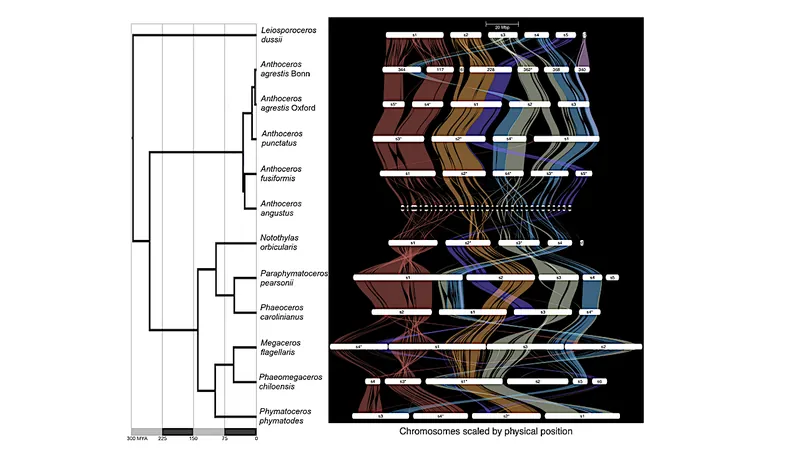
Fascinating Insights from Hornwort Genomes: Unlocking the Secrets of Plant Evolution from Water to Land
2025-01-07
Author: Siti
Introduction
Researchers have unveiled groundbreaking findings about the evolution of plants, focusing on hornworts—one of the earliest colonizers of terrestrial environments over 450 million years ago. These small, often overlooked plants have proven to be invaluable in understanding the transition from aquatic to terrestrial life, offering new clues about how life on Earth evolved, particularly in the face of changing environments.
Research Overview
In a recent study led by Peter Schafran, a postdoctoral researcher at the Boyce Thompson Institute (BTI), an international team of scientists successfully decoded the genomes of ten species of hornworts. “We aimed to capture a comprehensive look at hornworts, which represent different families within this unique plant group,” Schafran explained.
Genetic Stability and Chromosomes
The results were remarkable: hornworts showcased an intriguing genetic stability in their chromosomes, suggesting they have effectively maintained their genetic structures despite diverging over 300 million years. Unlike many other plants that have undergone whole-genome duplication—a process where their entire set of genetic material is replicated—hornworts have retained stable chromosomes known as “autosomes.” This is particularly significant given their long evolutionary journey, marking them as a point of interest in the broader study of plant genetics.
Accessory Chromosomes
However, not everything about the hornwort genome is static. The research also identified “accessory chromosomes,” which encompass extra genetic materials that, while not vital for basic survival, confer additional advantages. These accessory chromosomes exhibited significant variability and rapid evolution, demonstrating that some portions of the hornwort genome are actively adapting even within individual plants. The study also pinpointed potential sex chromosomes in various species, shedding light on the evolution of plant reproductive strategies.
Implications of Findings
Published in the journal *Nature Plants*, this research illuminates important characteristics of early terrestrial plants. For instance, it has revealed new insights into genes responsible for producing flavonoids—pigments that shield plants from harmful UV radiation—as well as mechanisms involved in forming stomata, the tiny pores critical for regulating gas exchange. These revelations enhance our understanding of how ancient plants adapted to their new land-based challenges.
The Importance of Diverse Organisms
This ambitious genetic exploration of hornworts places them at the forefront of plant studies, making them the most thoroughly sequenced group relative to their diversity. The comprehensive “pan-phylum” dataset developed by the researchers serves as a crucial tool for scientists aiming to understand the intricate evolutionary history and adaptability of plants.
Future Implications
Fay-Wei Li, an associate professor at BTI and co-author of the study, emphasized the vital importance of studying a wide range of organisms. “By looking beyond the traditional model species, we’re able to gain a more holistic picture of plant evolution and the astonishing variety of life on our planet,” he stated.
This innovative research not only heightens our understanding of plant evolution but also has significant implications for the future of agriculture. As climate change poses new environmental challenges, studying these resilient organisms could aid in the development of crops engineered to endure harsher conditions.
Conclusion
As scientists continue to explore the complexity of plant life on Earth, the insights from hornwort genomes may pave the way for advances in sustainable agriculture, food security, and ecological preservation, ensuring that our planet's green legacy continues.


 Brasil (PT)
Brasil (PT)
 Canada (EN)
Canada (EN)
 Chile (ES)
Chile (ES)
 Česko (CS)
Česko (CS)
 대한민국 (KO)
대한민국 (KO)
 España (ES)
España (ES)
 France (FR)
France (FR)
 Hong Kong (EN)
Hong Kong (EN)
 Italia (IT)
Italia (IT)
 日本 (JA)
日本 (JA)
 Magyarország (HU)
Magyarország (HU)
 Norge (NO)
Norge (NO)
 Polska (PL)
Polska (PL)
 Schweiz (DE)
Schweiz (DE)
 Singapore (EN)
Singapore (EN)
 Sverige (SV)
Sverige (SV)
 Suomi (FI)
Suomi (FI)
 Türkiye (TR)
Türkiye (TR)
 الإمارات العربية المتحدة (AR)
الإمارات العربية المتحدة (AR)